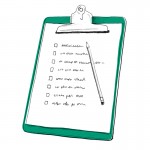Believe it or not, recruiters – which includes HR and hiring managers – spend almost all of their resume review time on the following resume points: your name, your current title and company, your current position start and end dates, your previous title and company, your previous position start and end dates, and your education.
According to groundbreaking research by TheLadders, a scientific technique called “eye tracking” was used to track where and how long a person focuses when digesting information of a resume. They brought in thirty professional recruiters over a 10-week period to record them as they viewed different types of resumes, online profiles, and other forms of candidate information.
The scary fact is that the eye tracking technology shows that recruiters only spent about six seconds on their initial “fit or not fit” decision. Aaarrrggghhh – I hear you scream!
According to the research, recruiters tend to follow a consistent visual pattern when reviewing both traditional resumes on their computer as well as online profiles like LinkedIn. The study concludes that a professionally written resume with an organised layout and clear visual hierarchy ensures recruiters make a better-qualified decision.
Regarding online profiles, TheLadders report revealed that recruiters were clearly distracted by common visual features such as pictures, ads, etc. It says: “These distractions wasted time and detracted from more pertinent and useful candidate information such as experience and skills. Such visual elements reduced recruiters’ analytical capability and hampered decision-making. In some cases, irrelevant data such as candidates’ age, gender or race may have biased reviewers’ judgments”.
The two resumes here, each with a different layout, shows a heat map of the recruiters’ eye movements. The one on the right was looked at more thoroughly than the one of the left because of its clear and concise format.
The study also showed that a well laid out resume beats any LinkedIn or other online profile again and again. The simple reason is that LinkedIn’s profiles had higher levels of visual complexity, and their ease of use suffered substantially as a result. Advertisements and other “calls-to-action” in the margins clutter the overview and reduce the recruiters’ ability to quickly process the profiles.
Oh, and by the way, drop that photo from your resume. Pictures naturally draw the eye; the recruiter fixates their attention for too long instead of examining other vital candidate information.
Botox your resume with these great tips
- Always keep in mind that the resume only has one function: to get you an interview.
- It is not necessary to include names and addresses of any referees. Reference checking takes place only at the time where the employer has decided to offer you employment.
- Recruiters, that is the HR department or consultants from executive recruitment companies, love to know the reasons for leaving jobs. You should be ready to answer these questions – but not in your resume, only when asked during the interview. Simply leave out any information about why you left a job.
- Every business has their own jargon, their own short words, that people in the business know well. As it might not be the line manager (i.e. someone familiar with this terminology) who will be taking a first look at all the resumes and applications, but rather the HR department or a recruitment company, you should avoid using abbreviations.
- If you have a degree or qualification relevant to the job you are applying for, this should obviously be included under the headline Education. Do not enclose copies of your diplomas and certificates. Instead bring the copies along for the interview in case the recruiter would like to check your educational credentials.
- Go for the standard and acceptable Microsoft Word document and you are on safe ground. Drop the Excel or PowerPoint documents for your resume.
- Do not use a file name such as resume.doc or the employer’s company name. Use your own first and last name as the file name when you save the document on your computer.
- Turn to a professional for resume re-writes; you should insist on an organised layout and a strong visual hierarchy; click here to see an example of the perfect resume.

TheLadders is a subscription based comprehensive job-matching service and employment website, headquartered in New York City. The report was prepared by Will Evans, Experience Design. You can download the report here.

